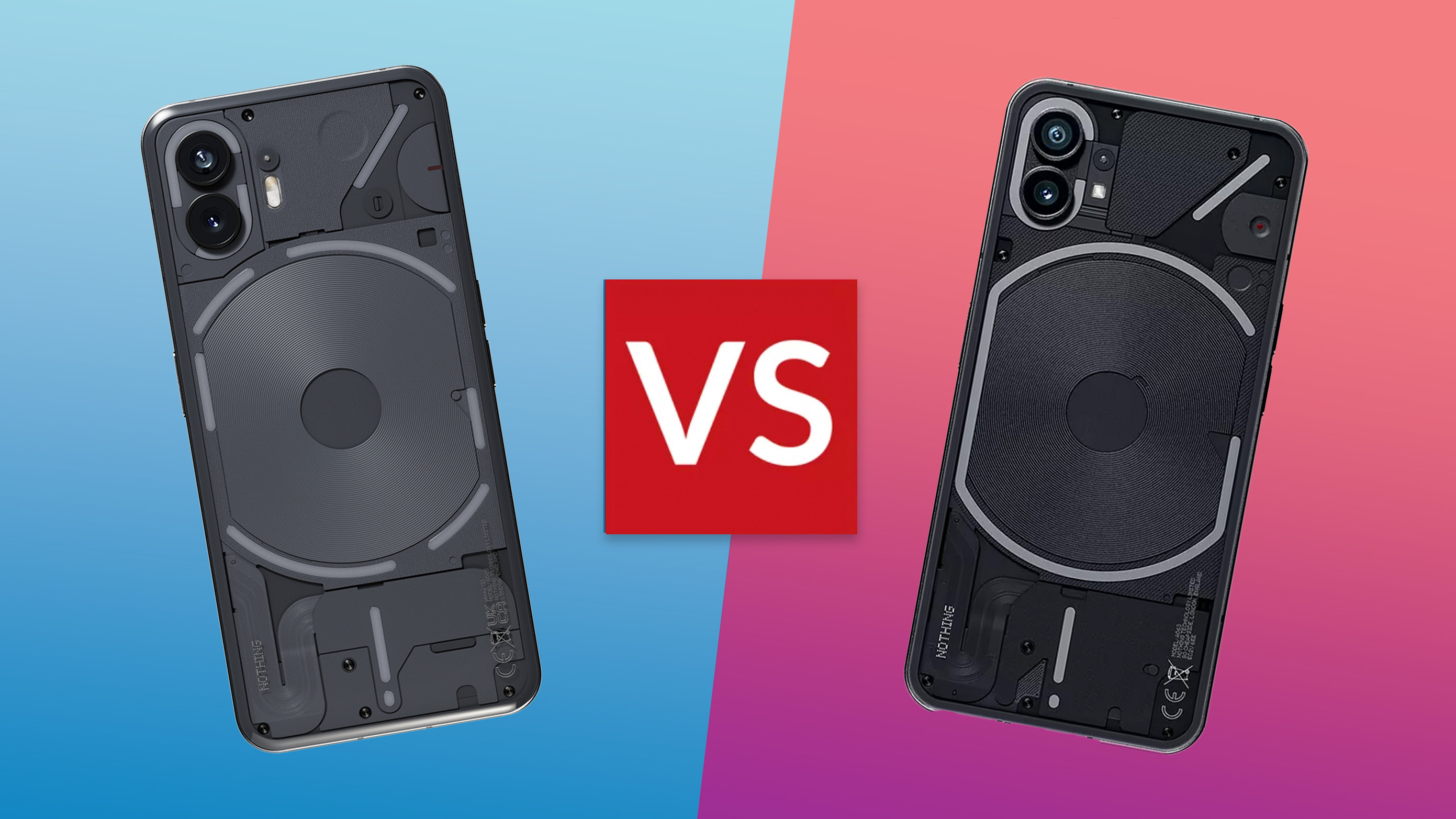

After seeing the Nothing Phone (2), it's easy to wonder why you'd think of picking up the inferior Nothing Phone (1) (unless you're in the USA, where the older device won't go on sale). After all, the Nothing Phone (1)'s specs trail behind the Phone (2) in every respect on paper – and yet Nothing's still selling both phones – so which is best for you?
The Nothing Phone (1) was the London-based phone maker's debut; launching in July 2022, it introduced the world to its Glyph lights and an interface and audio identity that tried to stand out with dot-matrix visuals and 8-bit sounds. It also cost just £399, which made it one of the cheapest options around to offer wireless charging and a camera system with optical image stabilisation (OIS).
While we appreciated the value on offer when we first tested it, mediocre battery life, a half-baked interface, and hit-and-miss photo processing held the debut Nothing Phone back from greatness. But a year since it launched, the Phone (1) has become a much better mobile thanks to plenty of software updates, and it's staying on shelves alongside the Phone (2), which launches as a pricier, more premium alternative.
Price
The Phone (1) didn't launch in the US, though is available in the UK, India, and other regions. Meanwhile, the Phone (2) is Nothing's official debut in US markets, with availability in existing markets as well. So depending on where you are you might not even be in a position to pick between both devices.
Fire up Nothing's online store in the UK, and the Phone (1)'s price hasn't dropped since launch, so it costs £399 (around $510) with 128GB storage and 8GB RAM, £449.00 (around $570) for 256GB storage and 8GB RAM, and £499 (around $640) 512GB storage and 12GB RAM.
As for the Phone (2), despite also starting with 128GB storage and 8GB RAM, the entry-level model costs a pricier £579/$599. If you want more of everything, the 256GB storage and 12GB RAM option costs £629/$699, while the 512GB and 12GB RAM Phone (2) costs £699/$799.
Whichever way you cut it, therefore, the Phone (2) is the pricier option, and if you shop around, you'll likely be able to pick up the first Nothing phone at a discount (especially during the Amazon Prime Day sales, which is taking place the same day as the Phone (2)'s reveal!), making it a great buy considering all the updates it's had since launch.
Get all the latest news, reviews, deals and buying guides on gorgeous tech, home and active products from the T3 experts
Design

At a glance, the Nothing Phone (1) and Nothing Phone (2) look very similar, but a closer look highlights plenty of small updates that help the first and second-generation smartphone stand apart.
Firstly, there's the glass back panel. With a slight curve at the edges, the Nothing Phone (2) sits a bit softer in the hand than the super-flat-backed Phone (1).
Next, the shape. The Nothing Phone (1) had an almost identical footprint to the iPhone 14 Pro Max. For 2023, Nothing has gone for a more traditional aspect ratio, making the Phone (2) a little taller.
Weighing 201.2g, the Phone (2) is a bit heavier, and at 8.6mm, it's also slightly thicker than the 193.5g, 8.3mm Phone (1), though side-by-side they are very comparable in both the hand and pocket.
While the Phone (1) was splash-resistant, rated to IP53, the Phone (2)'s been given a minor upgrade to IP54, though neither should be submerged if you want their Glyph Lights to keep flickering (in a good way).
The front of the phones also reflects a refresh to the selfie camera position, having moved from the left corner of the Phone (1) to the centre of the Phone (2)'s screen. Around the back, the Glyph patterns have also been segmented on the Phone (2) for greater isolation.
While both the Nothing Phone (1) and Phone (2) are available in White, for the 2023 model, Nothing has dropped Black in favour of Grey. Although, possibly maybe, there'll be a special edition Black later down the line (as there has been with Ear (2) earbuds).
Display
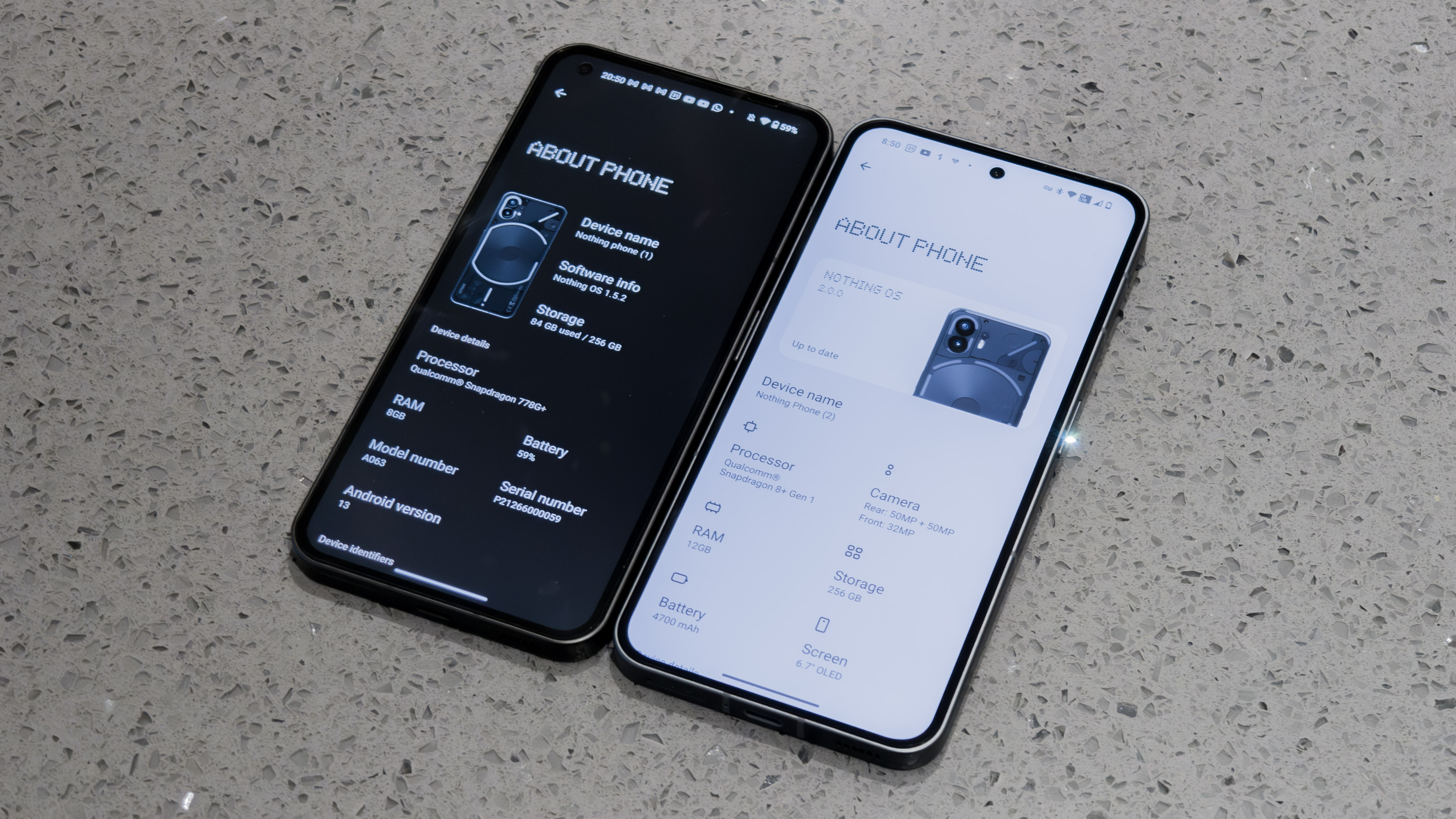
Both the Nothing Phone (1) and Phone (2) have wide Full HD resolution OLED displays with 120Hz refresh rates; they both support HDR10 high dynamic range content, and in the bottom centre of each is an in-display fingerprint scanner.
The Phone (2) has a larger screen – 6.7-inches versus the Phone (1)'s 6.55-inch display. To spot other major display differences, we'll need to get granular, and the first point is on resolution. The Phone (2)'s extra height is reflected in a slightly higher vertical resolution of 2412 – only a fraction higher than the 2400 resolution of the original.
Despite these slight resolution and size differences, both phones are about as sharp as one another – roughly 400 pixels per inch (PPI). Where the Phone (2) really edges ahead, though, is brightness. Low peak brightness was a criticism of the Phone (1), with its screen capping out at around 700 nits. The Nothing Phone (2), by contrast, climbs up to around 1,000 nits in typical use, though can pump pixels up to 1,600 nits when displaying HDR content.
Hardware
What makes the Nothing Phone (2) so appealing is that it gets a major spec bump over the Phone (1) in the form of its Qualcomm Snapdragon 8+ Gen 1 internals. Before even using it, we know that this processor can tear through top-tier games like Diablo Immortal and Genshin Impact. So if you're a gamer with an eye on a Nothing Phone, save your pennies and pick up the Phone (2) as the more sensible option.
For casual users, the Snapdragon 778+ 5G in the original Phone (1) should deliver the core Nothing experience in a capable package. It's well-suited to basic 3D games, and is more than up to the task when it comes to day-to-day apps like Chrome, Gmail and Spotify.
Both Nothing Phones start with 128GB storage and 8GB RAM, and neither has expandable storage, so you can't put a microSD card in for more. They can also be had with 256GB storage and 12GB RAM, but for file-hoarders, the Nothing Phone (2) is the only one available with 512GB storage.
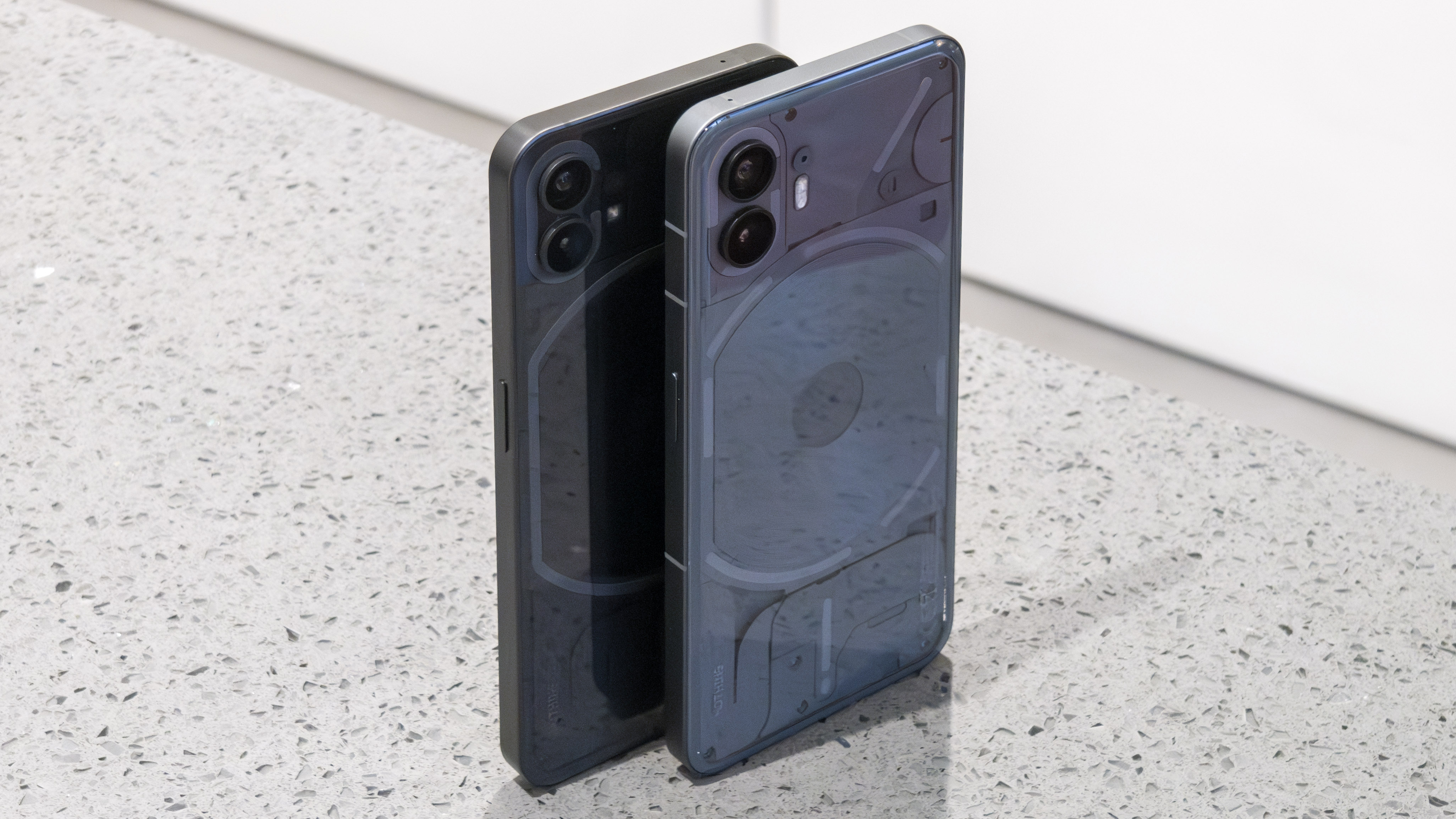
When it comes to battery life, while we can't comment on real-world use at this stage, the Nothing Phone (1)'s 4500mAh battery is outranked by the larger Phone (2)'s 4700mAh cell. The Phone (2) also charges at a faster 45W versus the 33W Phone (1), so should deliver a full charge in 55 minutes versus the original's 70 minutes.
Both the Nothing Phones pack 15W wireless charging, and they can also reverse charge at 5W, which might be slow when charging another phone, but they should power up the best earbuds and other accessories relatively quickly.
Nothing has committed to three years of Android updates and four years of software updates for both the Phone (1) and Phone (2). The Phone (1) will also be getting Nothing OS 2.0 – the same interface as the Phone (2) – so we can expect similar experiences across both in due course. That said, if you're buying your phone now, the Phone (2) is, naturally, better future-proofed by roughly a year.
Both phones serve up Glyph lights, and while the Phone (2)'s light strips are more segmented and smarter with third-party app integration and Glyph Composer, some of those features may also make their way to the Phone (1). Given Nothing's excellent track record with software updates, it wouldn't surprise us if this was the case.
Cameras
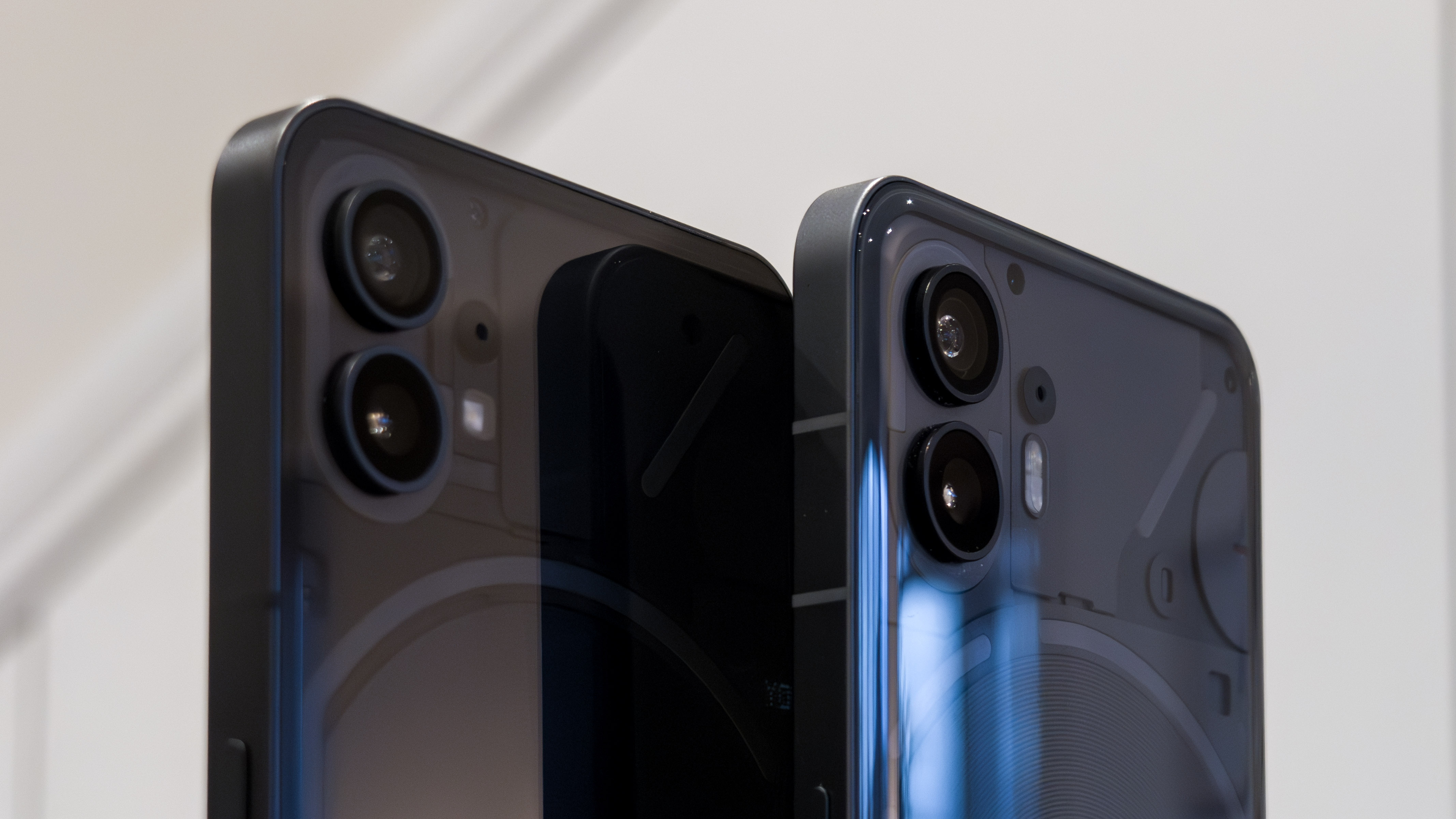
There really is very little in it when comparing the rear cameras of the two Nothing Phones. Both pack two 50-megapixel cameras with identical sensor sizes and similar optics.
While the original Nothing Phone used a Sony IMX766 main sensor, the Phone (2) gets a minor upgrade to the Sony IMX890. With both sensors measuring 1/1.56-inch, we would expect them to have similar properties, though the Phone (2) will bring Nothing's latest photo processing and camera experiences.
Both phones also enjoy optical stabilisation (OIS) and an f/1.9 aperture on their main cameras, and Nothing has brought back the same 50MP ultra-wide camera it debuted on the Phone (1) for the Phone (2), combining a Samsung JN1 1/2.76-inch sensor with an f/2.2 lens and autofocus.
For 2023, the selfie camera on the Phone (2) has been upgraded to a 32MP Sony IMX615 with an f/2.34 aperture. That's up from a 16MP sensor on the original.
| Nothing Phone (2) | Nothing Phone (1) | |
| Main camera | 50 MP, f/1.9 aperture,1/1.56-inch sensor size, optical stabilisation (OIS) | 50 MP, f/1.9 aperture,1/1.56-inch sensor size, optical stabilisation (OIS) |
| Wide-angle camera | 114-degrees, 50MP, f/2.2 | 114-degrees, 50MP, f/2.2 |
| Front camera | 32MP, f/2.45 | 16MP, f/2.5 |
Thanks to its upgraded power, the Nothing Phone (2) can also record higher frame rate video – up to 60fps at 4K resolution – versus the Nothing Phone (1), which capped out at 30fps at 4K.
In advance of the Nothing Phone (2)'s full reveal, T3 shared some images from the phone's cameras, as the big boss, Carl Pei, took to Twitter to encourage all pre-seeded users with the device to share (but not comment) their shots.
Conclusion
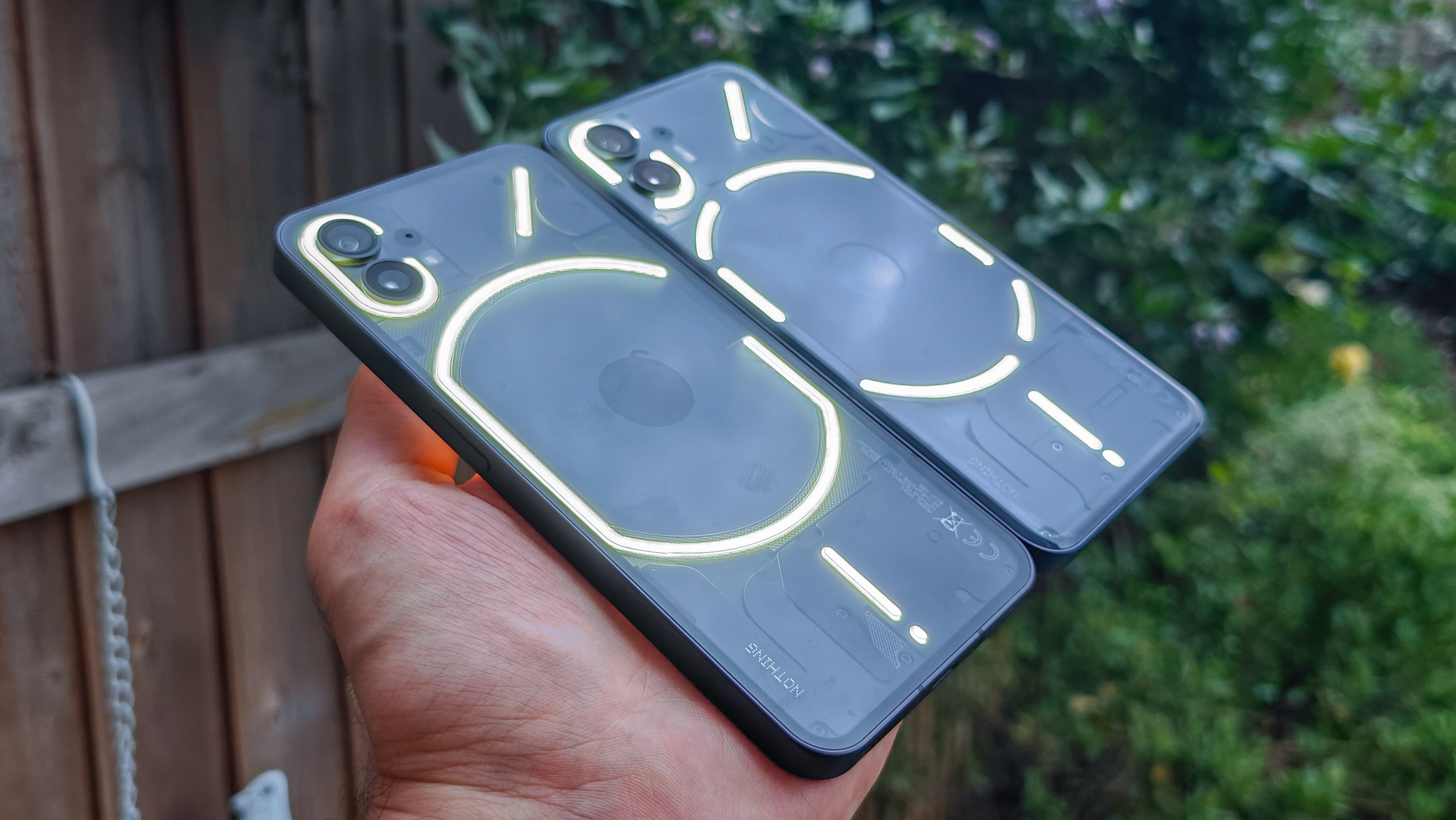
The main decider between the two phones will likely be price and availability. If you're in a region that sells the Nothing Phone (1), like the UK, and you want a more affordable option, it's the obvious choice. It's still a great shout if wireless charging and a camera with stabilisation (OIS) are on your wishlist, and with the promise of Nothing OS 2.0 and another two years of software update support, is still as future-proofed as many Android phones launching today.
For anyone looking for enough power to drive demanding 3D games, a more refined spec-roster, three years of software updates, and Nothing's guaranteed latest experiences, including more complex Glyph lighting, however, the Nothing Phone (2) takes the win. It's a more refined design overall, too, which may sound minor but ought to win it new fans the world over. Indeed, T3's Tech Editor, Mike Lowe, already has 3 Nothing Phone (2) Features He Can't Live Without.

Basil has been writing about tech for over 12 years, with bylines in TechRadar, Metro, Wired, and Digital Camera World – to name but a few titles. He expertly covers everything from mobile phones to smart devices, cameras, audio-visual hardware, and kitchen tech. In addition to his extensive journalism experience, Basil is also skilled in video production, content strategy, and vegan baking, and runs Tech[edit], a technology-focused YouTube channel.